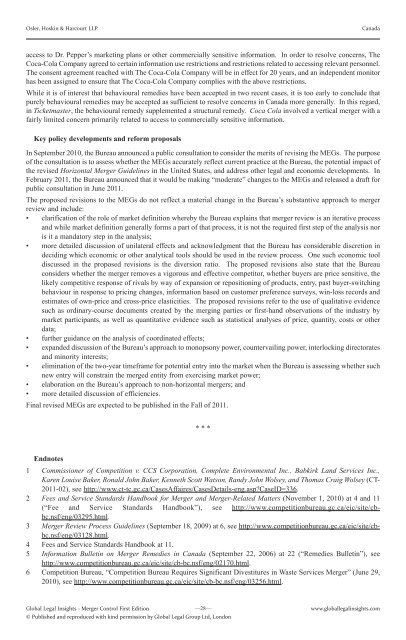Merger Controls First Edition - J Sagar Associates
Merger Controls First Edition - J Sagar Associates
Merger Controls First Edition - J Sagar Associates
Create successful ePaper yourself
Turn your PDF publications into a flip-book with our unique Google optimized e-Paper software.
Osler, Hoskin & Harcourt LLP Canada<br />
access to Dr. Pepper’s marketing plans or other commercially sensitive information. In order to resolve concerns, The<br />
Coca-Cola Company agreed to certain information use restrictions and restrictions related to accessing relevant personnel.<br />
The consent agreement reached with The Coca-Cola Company will be in effect for 20 years, and an independent monitor<br />
has been assigned to ensure that The Coca-Cola Company complies with the above restrictions.<br />
While it is of interest that behavioural remedies have been accepted in two recent cases, it is too early to conclude that<br />
purely behavioural remedies may be accepted as sufficient to resolve concerns in Canada more generally. In this regard,<br />
in Ticketmaster, the behavioural remedy supplemented a structural remedy. Coca Cola involved a vertical merger with a<br />
fairly limited concern primarily related to access to commercially sensitive information.<br />
Key policy developments and reform proposals<br />
In September 2010, the Bureau announced a public consultation to consider the merits of revising the MEGs. The purpose<br />
of the consultation is to assess whether the MEGs accurately reflect current practice at the Bureau, the potential impact of<br />
the revised Horizontal <strong>Merger</strong> Guidelines in the United States, and address other legal and economic developments. In<br />
February 2011, the Bureau announced that it would be making “moderate” changes to the MEGs and released a draft for<br />
public consultation in June 2011.<br />
The proposed revisions to the MEGs do not reflect a material change in the Bureau’s substantive approach to merger<br />
review and include:<br />
• clarification of the role of market definition whereby the Bureau explains that merger review is an iterative process<br />
and while market definition generally forms a part of that process, it is not the required first step of the analysis nor<br />
is it a mandatory step in the analysis;<br />
• more detailed discussion of unilateral effects and acknowledgment that the Bureau has considerable discretion in<br />
deciding which economic or other analytical tools should be used in the review process. One such economic tool<br />
discussed in the proposed revisions is the diversion ratio. The proposed revisions also state that the Bureau<br />
considers whether the merger removes a vigorous and effective competitor, whether buyers are price sensitive, the<br />
likely competitive response of rivals by way of expansion or repositioning of products, entry, past buyer-switching<br />
behaviour in response to pricing changes, information based on customer preference surveys, win-loss records and<br />
estimates of own-price and cross-price elasticities. The proposed revisions refer to the use of qualitative evidence<br />
such as ordinary-course documents created by the merging parties or first-hand observations of the industry by<br />
market participants, as well as quantitative evidence such as statistical analyses of price, quantity, costs or other<br />
data;<br />
• further guidance on the analysis of coordinated effects;<br />
• expanded discussion of the Bureau’s approach to monopsony power, countervailing power, interlocking directorates<br />
and minority interests;<br />
• elimination of the two-year timeframe for potential entry into the market when the Bureau is assessing whether such<br />
new entry will constrain the merged entity from exercising market power;<br />
• elaboration on the Bureau’s approach to non-horizontal mergers; and<br />
• more detailed discussion of efficiencies.<br />
Final revised MEGs are expected to be published in the Fall of 2011.<br />
* * *<br />
1<br />
Endnotes<br />
Commissioner of Competition v. CCS Corporation, Complete Environmental Inc., Babkirk Land Services Inc.,<br />
Karen Louise Baker, Ronald John Baker, Kenneth Scott Watson, Randy John Wolsey, and Thomas Craig Wolsey (CT-<br />
2011-02), see http://www.ct-tc.gc.ca/CasesAffaires/CasesDetails-eng.asp?CaseID=336.<br />
2 Fees and Service Standards Handbook for <strong>Merger</strong> and <strong>Merger</strong>-Related Matters (November 1, 2010) at 4 and 11<br />
(“Fee and Service Standards Handbook”), see http://www.competitionbureau.gc.ca/eic/site/cb-<br />
3<br />
bc.nsf/eng/03295.html.<br />
<strong>Merger</strong> Review Process Guidelines (September 18, 2009) at 6, see http://www.competitionbureau.gc.ca/eic/site/cbbc.nsf/eng/03128.html.<br />
4 Fees and Service Standards Handbook at 11.<br />
5 Information Bulletin on <strong>Merger</strong> Remedies in Canada (September 22, 2006) at 22 (“Remedies Bulletin”), see<br />
http://www.competitionbureau.gc.ca/eic/site/cb-bc.nsf/eng/02170.html.<br />
6 Competition Bureau, “Competition Bureau Requires Significant Divestitures in Waste Services <strong>Merger</strong>” (June 29,<br />
2010), see http://www.competitionbureau.gc.ca/eic/site/cb-bc.nsf/eng/03256.html.<br />
Global Legal Insights <strong>Merger</strong> Control <strong>First</strong> <strong>Edition</strong><br />
—28—<br />
© Published and reproduced with kind permission by Global Legal Group Ltd, London<br />
www.globallegalinsights.com


